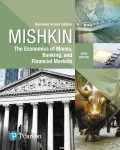
In case the question requires us to explain the three motives for holding money by Keynes in hid liquidity preference theory.
Concept Introduction:
Liquidity preference theory: Late Lord J. M. Keynes propounded the Liquidity Preference Theory to explain the interest rate determination with the help of
Liquidity is a term used to describe how quickly an asset can be converted into cash. If you keep the money in some other form of asset, or in bank, you will actually have a separation with the liquid form. Liquidity is the easiness of holding cash form of money rather than any other form. Interest rate is considered as the compensation for separation with the liquidity form of money.
Want to see the full answer?
Check out a sample textbook solution
Chapter 22 Solutions
EBK ECONOMICS OF MONEY, BANKING AND FIN
- not use ai pleseaarrow_forward3 Producer Surplus, PS $12 $11 S Book Print rences Legend ●Demand ● Supply Price $10 $9 $8 $7 $6 D $5 0 1 2 3 4 5 6 7 8 00 Tons of Wheat (in thousands) 9 10 a. Indicate the consumer surplus if the market is in equilibrium. Instructions: Use the tool provided "Consumer Surplus, CS" to shade in the consumer surplus area on the graph. b. Indicate the producer surplus if the market is in equilibrium. Instructions: Use the tool provided "Producer Surplus, PS" to shade in the producer surplus area on the graph.arrow_forwardFigure 4-4 PRICE a P B Q a QUANTITY Supply Refer to Figure 4-4. The movement from point A to point B on the graph is called a decrease in supply. an increase in supply. an increase in the quantity supplied. a decrease in the quantity supplied. tv all A 18arrow_forward
- A linear programming computer package is needed. As part of the settlement for a class action lawsuit, Hoxworth Corporation must provide sufficient cash to make the following annual payments (in thousands of dollars). 6 Year 1 23. 4 Payment 160 185 210 255 285 430 The annual payments must be made at the beginning of each year. The judge will approve an amount that, along with earnings on its investment, will cover the annual payments. Investment of the funds will be limited to savings (at 4% annually) and government securities, at prices and rates currently quoted in The Wall Street Journal. Hoxworth wants to develop a plan for making the annual payments by investing in the following securities (par value = $1,000). Funds not invested in these securities will be placed in savings. Security Current Price 1 $1,055 Rate (%) Years to Maturity 6.750 3 2 $1,000 5.125 Assume that interest is paid annually. The plan will be submitted to the judge and, if approved, Hoxworth will be required to…arrow_forwardPut the sections of Cornell notes in the order of completion.arrow_forwardagree or disagree with the post Hi Class! Egyptian dates are much sweeter! Due largely to their climate and geography, Egypt, Saudi Arabia, Algeria, and Iran produce more dates than either the US or Canada. Dates grow best in hot dry climates with long dry growing seasons, which these nations naturally offer. They also produce a lot of dates because of their extensive agricultural, infrastructure, and centuries-old date-growing expertise. Conversely, the U.S., there aren't many places in Canada and California that are suitable for date farming, only a select few, like the Coachella Valley, in California can produce dates on a large scale. Although California produces some dates, it is not as much as countries like Saudi Arabia and Egypt. Depending only on U.S., because of increased labor and production costs, dates grown in this way may have a limited supply and raise prices. We can obtain a greater supply of dates at competitive prices while maintaining consistent quality by…arrow_forward
- In 1932 babe Ruth made $75,000. How much is that in todays dollars please give the right answer step by steparrow_forwardEvaluate machine XYZ when MARR is 12% per year. Pertinent data are as follows: Machine XYZ Investment cost Expected life Market (salvage) value Annual revenue Annual expenses $10,000 5 years $1,000 $8,000 $4,000 How much is the excess of the cash flow using the Annual Worth Method? Blank 1 Calculate the External Rate of Return. Blank 2 Compute the payback period of the investment. Blank 3 Would you recommend this investment? Explain briefly. Blank 4arrow_forwardPlease make sure to answer each step and show work. Thank you!arrow_forward

 Principles of Economics (12th Edition)EconomicsISBN:9780134078779Author:Karl E. Case, Ray C. Fair, Sharon E. OsterPublisher:PEARSON
Principles of Economics (12th Edition)EconomicsISBN:9780134078779Author:Karl E. Case, Ray C. Fair, Sharon E. OsterPublisher:PEARSON Engineering Economy (17th Edition)EconomicsISBN:9780134870069Author:William G. Sullivan, Elin M. Wicks, C. Patrick KoellingPublisher:PEARSON
Engineering Economy (17th Edition)EconomicsISBN:9780134870069Author:William G. Sullivan, Elin M. Wicks, C. Patrick KoellingPublisher:PEARSON Principles of Economics (MindTap Course List)EconomicsISBN:9781305585126Author:N. Gregory MankiwPublisher:Cengage Learning
Principles of Economics (MindTap Course List)EconomicsISBN:9781305585126Author:N. Gregory MankiwPublisher:Cengage Learning Managerial Economics: A Problem Solving ApproachEconomicsISBN:9781337106665Author:Luke M. Froeb, Brian T. McCann, Michael R. Ward, Mike ShorPublisher:Cengage Learning
Managerial Economics: A Problem Solving ApproachEconomicsISBN:9781337106665Author:Luke M. Froeb, Brian T. McCann, Michael R. Ward, Mike ShorPublisher:Cengage Learning Managerial Economics & Business Strategy (Mcgraw-...EconomicsISBN:9781259290619Author:Michael Baye, Jeff PrincePublisher:McGraw-Hill Education
Managerial Economics & Business Strategy (Mcgraw-...EconomicsISBN:9781259290619Author:Michael Baye, Jeff PrincePublisher:McGraw-Hill Education





